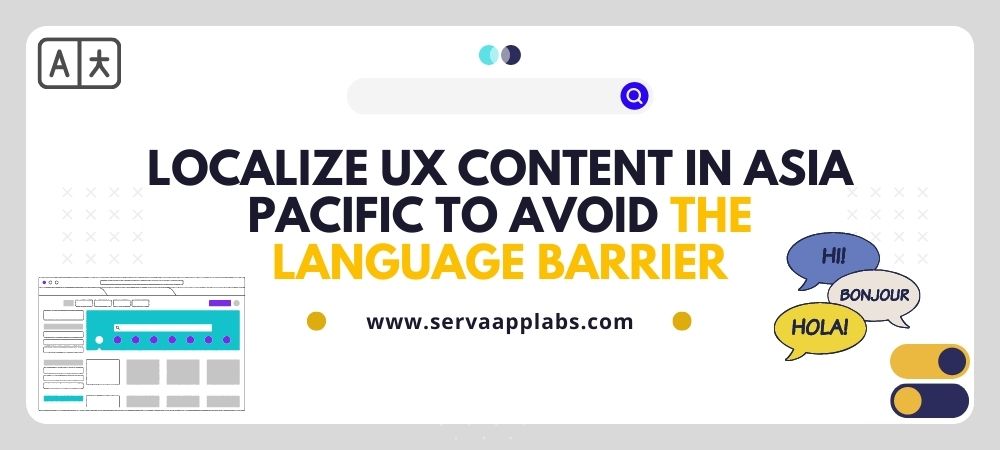Introduction
APAC Region is home to 60% of the world’s population, and its fast-growing digital market offers a great entry point for global companies. However, when entering a culturally diverse market like APAC, companies need to be aware of one thing: the language barrier. APAC is home to over 3,200 languages and dialects, not to mention a vibrant tradition and historical culture. Faced with this, businesses must find ways to break down these barriers where localization is a must. For example, if we decide to create a new website or application for this market, we need to localize the UX content to suit the local culture and language.
What is UX content? Why one should use UX content and localization ? What elements of UX design can be localized and how does he localize UX content in Asia Pacific? Through this article Discover!

What is UX content? Why should I localize my content?
UX content consists of text, pictures, graphics, and media within a website or application. It is the UX/UI designer’s responsibility to arrange content in a way that is accessible, usable, and meaningful to the user.
Localization, on the other hand, adapts content to a specific target region. This is text, graphics, layout, or any customization of the content displayed on the platform. Localization is very important as it drives multilingual marketing. Content localization personalizes the user experience of your content and helps users connect, relate, and resonate with your product. There are many examples of great localized content from top companies like Netflix. Localize your content for a global audience through dubbing, subtitling, and closed captioning. The staff in these roles, mostly local freelancers, can streamline the localization process on Netflix’s streaming platform. Netflix also recommends different choices to users based on the popularity of movies in the user’s location. As such, the user experience on Netflix is well tailored and personalized
Previous research has also proven the effectiveness of localization efforts on business performance. According to Nimdzi Insights:
- UX localization can help companies increase local sales by 100-400%.
- 70% of his customers said they would be hesitant to pay in an online storefront if it didn’t have a localized experience.
- 90% say they are more likely to buy a product or service localized for their market.
- Localization in 10 languages allows the company to reach his 90% of online consumers worldwide.
Which elements can UX/UI designers localize?
Localization is often referred to simply as translation, but it is actually much more extensive. Translation is simply the process of converting text from one language to another, while preserving meaning and context. Localization, on the other hand, requires UX designers to target and address digital products according to audience pain points in order to provide the best customer experience.

In general, factors her UX/UI designer can change when localizing UX content include:
Font:
When localizing your UX, you need to choose fonts that support multiple languages. Consider space requirements as well as different characters. Many countries in the Asia-Pacific region have their own typography, such as Japan, South Korea, and Vietnam. Therefore, you should thoroughly research which fonts are popular in a particular country.
Format:
Most scripts are now written left-to-right, but some countries still use a right-to-left format. For example, Dhivehi/Maldives, a right-to-left language used in the Maldives. Designers should keep this in mind as reversing the direction of the language can impact the overall navigation and layout of UX content.
Picture:
When using images or photos for your UX, remember to adapt your images to the culture of the country. Showing specific places and local people in your interface makes it more accessible and inspiring for your target audience.
What are the potential challenges in localizing content?
The localization process presents certain challenges that hinder business efforts. With that in mind, look for strategies to overcome it!
An error occurred while translating the content
There are many potential risks companies face when translating content from one language to another. Language includes not only words, but also the culture of the country. When it comes to language, it is expected that there will be different words with similar meanings but used in different contexts. For example, in English we have “friend” and “mate” which mean the same thing. However, “friend” is neutral and can be used both formally and informally, while “mate” is used only in informal contexts.
So when localizing your content, pay attention to the context, tone and mood of the words you choose. Inappropriate word choices for localized product versions can result in a poor user experience.
Character Limit
The process of translating the original text into other languages can increase the length of the text. This can cause problems in your design and you should consider shorter solutions that are not optimal for optimizing user experience. The best solution to this problem may be for UX/UI experts and linguists to work together to create the best possible digital product.
This process requires a lot of time and internal resources
Completing the localization process requires devoting resources to research, product customization, and testing. Remember, when entering a new market, don’t cut corners in haste, as each phase is critical to ensuring the quality of the released product. Some companies have done this, but their efforts have yielded poor results.A study by the Content Marketing Institute found that brands delivering poorly localized content achieved their sales goals. 40% less likely to do so.
4 Ways to Localize UX Content in Asia Pacific
- Build a diverse team – Building a diverse team can be beneficial if you decide to expand your business into the Asia Pacific region. Eastern teammates with deep knowledge and experience of local culture can help make customized UX content more appealing to users.
- Conducting ethnographic research – Ethnographic research allows us to understand the culture of the Asia-Pacific market. In addition, you can develop a deeper knowledge of your users’ motivations and pain points. There are several ways to conduct ethnographic research, including:
- Collect reports on culture
- Meet users face-to-face and experience the local culture.
- Experience their online products.
- Use symbols in your theme – As time goes on, icons are becoming more and more popular all over the world. Certain symbols have the same meaning in different countries, regardless of language. This is because the icons are easy to recognize and navigation is simplified, providing an easy and seamless user experience. Using icons instead of text labels for items whenever possible not only reduces translation effort, but also reduces the number of redesigned items that are customized during localization
- Outsourcing – Sometimes companies find it difficult to find enough staff, or the workflows to localize are too complex. Leveraging the expertise of UX professionals such as UX design agencies is a good attempt. With years of experience and deep linguistic and cultural expertise, our agency can help streamline your workflow and ensure the success of your localization efforts.
Final Thoughts
Entering the Asia-Pacific market can be very difficult for companies due to language barriers and other potential cultural issues. Effectively targeting local users requires not only time and resources, but also a thorough cultural awareness of the new market. A well-prepared localization strategy that takes into account all of the above factors will increase your chances of business success.




